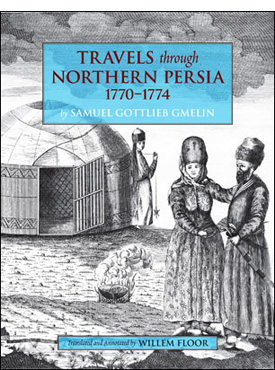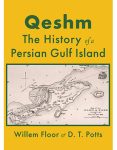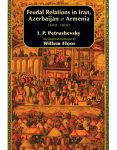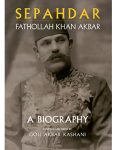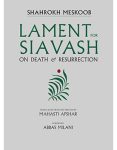About the Book
In 1770 the young German scientist and explorer Samuel Gottlieb Gmelin embarked on a journey on behalf of the Russian Academy of Sciences and in the service of Catherine the Great. These heretofore little-read accounts of his travels and broad research in Northern Persia, first published in German in St. Petersburg in the 1770’s, have now been translated for the first time into English by renowned scholar Willem Floor.
In the two voyages recounted in this volume, Gmelin kept journals describing the customs, industry, political world, warfare, geography, and plant and animal life of Northern Persia, until his capture and imprisonment in the village of Parakay near the Caspian Sea in 1774—a misfortune that he also was able to record, and which is included here in the final volume of his travelogue.
Includes the third and fourth volumes of Gmelin’s four-part travelogue Travels through Russia to Investigate the Three Natural Realms, as well as the 1784 preface, and an appendix with further accounts by Gmelin’s student. Gmelin’s entries describe, among many things, the political situation and wars in Persia; the temperament and physical characteristics of the Persians; the people’s table manners and hygiene; Persian money, weights and measures; the court of the Khan of Gilan; the Gilani language; Persian monks; Persian medical science; Shi`a Islam; the Jews of Rasht; the Persian attitude toward Christians; treatment of women; the plant and animal life of Persia; the Turkmen tribes of the east Caspian; the mountain peoples of Daghestan; the potential for Russian trade with the peoples of Persia; the Persian Armenians and their mercantile activity; and Persian methods of fishing, farming and preparing various foods. With thirty-eight illustrations.
Reviews
“This is an important book for those interested in Russian, Central Asian, and Persian studies.”
Choice, January 2008
Excerpt
Dear Reader,
You find herewith an English translation of volume 3 and most of volume 4 of Samuel Gottlieb Gmelin’s Reise durch Russland zur untersuchung der drey natur-reiche (Travels through Russia to investigate the three natural realms). There are two reasons why I decided to translate this Travelogue. First, it is an important source of information hardly ever used by scholars because the text is in German, which fewer and fewer scholars read, and, even if they do, they are put off by its Gothic script. The second reason is that this travelogue is very rare and the only way I ever could hope to own a copy of it was to translate it. As this has now been done I hope that more scholars will mine this travelogue for its information, which thus far very few have done. There is a French summary of it, but this is also a rare work and scholars have to know French, which fewer do than is desired. A Russian translation is also available, which is even rarer than the German version and for obvious reasons seldom used.
Since volumes 1 and 2 deal with Southern Russia I have not translated them, because I am only interested in those parts that deal with Gmelin’s travels through Persia. Volume 3 starts in Astrakhan, where Gmelin leaves by ship in June 1770. He travels to Darband, Baku, Shamakhi, Saliyan, Enzeli, Rasht and its hinterland, and then via Tonakebon to Mazandaran, where he falls foul of its governor, but he is finally allowed to depart and returns by ship via Enzeli to Astrakhan in April 1772. Volume 4 starts with a short trip to Zaryzin and the Kuban steppe; this covers 40 pages, but I have not translated them, because they do not deal with Persia. In July 1773, Gmelin once again leaves by ship from Astrakhan, this time to the East Coast of the Caspian Sea, to what is now Kazakhstan and provides interesting information on the Turkmen tribes and Nepthenoy Island. He then sails via Astarabad to Enzeli and from there travels overland through Talesh to Baku and Darband. Here Gmelin arranges for the last leg of his trip to Tarki, but things go wrong. The Usmi, one of the local mountain lords imprisons him and holds him hostage in February 1774. The lengthy negotiations finally result in a peaceful resolution, but too late for Gmelin, who died shortly before his scheduled release due to the miserable conditions in which he was held. Gmelin’s death provided the Russian government with an excellent excuse to launch a punitive expedition, which they had wanted to execute anyway. The fact that Fath `Ali Khan of Kuba, who was under siege by the Usmi in 1774, had asked for Russian assistance also provided a further incentive to invade the Northern Caucasus.
Peter Simon Pallas, the editor of Gmelin’s travelogue, has enlarged Volume 4 by adding a report on Russia’s Caspian trade, which Gmelin had prepared as a separate report. He further added a report by Hablizl, one of Gmelin’s students, who had been charged to collect additional information in the hinterland of Rasht, when Gmelin departed on his final journey to Darband.
The areas visited by Gmelin were also visited by other travelers during the 18th century in the post-Safavid era; none of these areas, however, were visited during the Zand period. Hanway visited Gilan, Mazandaran and Astarabad in the 1740s, while Bruce (1720s), Lerch (1730s, 1740s), and Cook (1740s) were in the Caucasus and Gilan either with Peter the Great’s troops (Bruce, Lerch) or with the embassy led by prince Golitsyn (Lerch, Cook). Apart from the passage of time, these other travelers did not provide detailed information on some of the ethnic groups living in Daghestan, the Turkmen on the east coast of the Caspian Sea, or on the `Amarlu in Gilan as did Gmelin. His detailed information on the towns and areas he visited is also of great importance, in particular his enumeration of the town quarters, the takiyehs of the `Ashura festival and the description thereof. Needless to say his discussion of political events during the years 1770-1772 and in particular the areas that he visited is of special importance. Other significant source books that the reader may wish to consult include that by Müller, which Gmelin refers to on occasion. Finally, I want to mention the book by Bakikhanuf, which deals with events in Azerbaijan and Daghestan. There are, of course, many other books and articles that are of relevance, but I have decided to mention only these. For those who are interested to read more, the footnotes mention other books, whose bibliographies will provide further suggestions and attractions to read.
For those not too familiar with, or totally ignorant of, this time of Persian history, I will provide a very brief sketch so as to place Gmelin’s travelogue in historical context. Those who want to know more are referred to a number of studies on this subject and era.
Since 1501, Persia had been ruled by the Safavid dynasty. The Eastern Caucasus area, although regularly contested by the Ottoman Empire in the past, had remained safely in Safavid hands since 1620. This remained so until the fall of the Safavid dynasty in 1722, when Afghan and Seystani forces led by Mahmud Khan of Qandahar took Isfahan and then the greater part of the kingdom. This led to a decade of turmoil. In 1723, the Russians took an area stretching from the Terek to Baku in the Caucasus, while they also took Enzeli and Rasht. Meanwhile, the sole surviving son of Shah Soltan Hoseyn (r. 1694-1722), who had fled besieged Isfahan established himself as Shah Tahmasp II, first in Azerbayjan, and when that became too unsafe in Gilan-Mazandaran. After suffering a defeat at the hand of the Afghans he moved to Astarabad around 1724. Here he received support from Fath `Ali Khan Qajar, whom he appointed as his vakil or regent. This exacerbated rivalry with one of Shah Tahmasp’s new supporters, the leader of a band of successful robbers, Tahmasp Qoli Khan, which resulted in the fall of Fath `Ali Khan, who was executed in 1726. Slowly, but gradually Safavid power was re-established over Khorasan culminating in a major battle in 1729 with the Afghan leader Ashraf Khan, who was totally defeated. Tahmasp Qoli Khan soon established control over the rest of the country and by the end of 1730 the Afghan threat had been eliminated. Meanwhile, relations between Shah Tahmasp II and Tahmasp Qoli Khan soured. The former played at being shah, leading a dissolute life doused with alcohol and women, while leading a disastrous campaign against the Ottomans, thus undoing some of the major gains that Tahmasp Qoli Khan had brought about. The latter, therefore, decided to engineer the shah’s disposal which took place in 1732. Tahmasp Qoli Khan, or Tahmasp Khan as he was henceforth known, became regent for the baby-shah `Abbas III. To make a clean break with the past Tahmasp Khan had himself hailed as Nadir Shah in 1736 on the Moghan steppe by a large gathering of local leaders from all over Persia. His continuous wars with the Ottomans, Moghuls, and Lezgis brought him fame, but the price was the ruination and death of the people of his kingdom, who suffered terribly. His increasingly outrageous behavior even upset his closest collaborators, and these were no daisies, so that revolts broke out and finally they decided to murder him. This happened in 1747 with the connivance of his nephew, who declared himself as `Adel Shah. The latter’s rule was challenged by his brother Ebrahim who defeated him in 1748. However, he in turn was defeated by his nephew Shahrokh in 1750. The result was that the kingdom that Nadir Shah had held together began to disintegrate and a succession war started between numerous contenders amongst which `Ali Mardan Khan Bakhtiyari, Hoseyn Khan Qajar, Azad Khan Afghan and Karim Khan Zand. Finally, it was Karim Khan Zand, who, as of 1763, was able to impose his will on most of the kingdom and he ruled not as shah, but as regent (vakil) for the absent Safavid kings until 1779. Thus Gilan, Mazandaran, Astarabad and Talesh, four governates that Gmelin visited in Northern Persia, were all nominally under Karim Khan’s control.
However, not all the parts that Gmelin visited were under Karim Khan’s influence. For example, the Caucasus, like the rest of the kingdom, had become the prize over which many contenders fought. One of the major winners was the Khan of Kuba who was able to acquire control over Shirvan, Darband, Shamakhi, Baku, Saliyan and Talesh. These were the very parts that Gmelin visited. Other parts of the Caucasus were held by various other rulers, who do not concern us here. Fath `Ali Khan of Kuba (r. 1758-1789) was Gmelin’s main interlocutor in the Caucasus and it is therefore interesting to provide some background information about him. Fath `Ali Khan’s ancestors were of the Qeytaq ethnic group (north of Darband) and of one of the two lineages that traditionally supplied the ruling head or Usmi. In the late 1660s, all members of one of these two lineages, except for one infant, were killed by the other rival lineage in a grab for uncontested power. This infant, the later Hoseyn Khan, was taken by loyal servants to Tarki and from there they fled to the Safavid court to save his life. The young Hoseyn Khan converted to Shi`ism and was then appointed by Shah Soleyman (r. 1666-1694) as governor of Kuba (1680-1721). Hoseyn Khan took residence in the town of Khodat, where he built a fortress-like residence. In 1722 his great-grandson Hoseyn `Ali became the new governor of Kuba. He was able to retain his position when Russian troops occupied the area in 1723, while he did the same under Nadir Shah (r. 1736-1747), who had negotiated an agreement with the Russians resulting in their withdrawal from Safavid lands in 1732. When Nadir Shah was killed in 1747, Hoseyn `Ali Khan did not support any of the pretenders to the throne, but carved out an independent position for himself. He also moved from Khodat, located in the coastal area, to Kuba in the high lands, which was easier to defend, and where he also built a fort. In 1757 Hoseyn `Ali Khan was also able to establish control over Saliyan. He died one year later and his son Fath `Ali Khan succeeded him. He continued to pursue his father’s policy, i.e. to maintain his independence, while extending his realm. Thus, he was able to annex Darband (1759), Baku (1767), Shamakhi (1768) and Talesh (1785). Fath `Ali Khan’s lands thus stretched from the Terek to the Astara and although his rule was not unchallenged (of which Gmelin gives several examples) he was able to bring some stability to a large area that had known devastating warfare for many years.
I do not provide an introduction to the life and works of Gmelin as this has already been done in 1774 by Pallas, the editor of the first and only edition of his travelogue, which follows this foreword. As to the translation itself, I have modernized all place names and Persian personal names and words. However, the first time these occur, I have also provided the orthography as used by Gmelin, which appears within (parentheses) after the modern version of the name or term. For example, to refer to Shi’ites or the Shi`a religion he uses terms such as Schias, Schachi, Schahier, Alianer, Aliani or he sometimes uses the term Iranski instead of Persian. Given that the orthography of Nadir is so common I have not changed it. Otherwise in transcribing Persian words a long ‘i’ is an ‘i’ and short ‘i’ is an ‘e’, a long ‘u’ is a ‘u’ and a short one an ‘o’. The long and short ‘a’ are both presented by an ‘a’.
Although the original text has neither a table of contents nor an index I have made both so as to facilitate the use of this travelogue. Whenever I have added clarifications in the text itself they appear between square [brackets]. This also holds when I have been unable to identify a village or a term or when I am uncertain about the identification. In that case the relevant original word is followed by [?]. I have also placed some other clarifications in the footnotes, which I have kept to a minimum. When the footnotes are by Gmelin, Hablizl or Pallas, I have explicitly indicated that. Gmelin sometimes uses Russian words in Cyrillic script in the text, which I have left as they were. Also, I sometimes provide Russian words in Cyrillic script, but only in the footnotes. I have not translated the few short descriptions of plants and animals that are in Latin. They do not really add to the information already available and anybody with a Latin dictionary will be able to understand what he or Hablizl have written. Gmelin referred to Carl von Linné as Linne or Ritter von Linne, which I have left unchanged in the text. Also, although I have translated where specific figures illustrate the text this does not mean that these illustrations are all to be found in this book. Only a limited number of figures has been reproduced from the third volume, while those found in volume 4 have all been reproduced. Furthermore, to facilitate verification of important passages with the original, I have indicated where the pages of the original German text end by inserting the page number in bold between square brackets [1].
About the Author
Willem Floor studied development economics and non-western sociology, as well as Persian, Arabic and Islamology from 1963-67 at the University of Utrecht (the Netherlands). He received his doctoral degree from the University of Leiden in 1971. Since 1983, Dr. Floor has been employed by the World Bank as an energy specialist. Throughout this time, he has published extensively on the socio-economic history of Iran. His books include: Public Health in Qajar Iran, Agriculture in Qajar Iran, and The History of Theater in Iran, as well as, The Persian Gulf: A Political and Economic History of 5 Port Cities, 1500-1730, its second volume, Persian Gulf: The Rise of the Gulf Arabs, 1747-1792, third volume, The Rise and Fall of Bandar-e Lengeh, the fourth volume, Bandar Abbas: The Natural Gateway of Southeast Iran, and the fifth volume, The Persian Gulf: Links with the Hinterland Bushehr, Borazjan, Kazerun, Banu Ka’b, & Bandar Abbas. He has also published, Travels Through Northern Persia, 1770-1774, Titles and Emoluments in Safavid Iran, and A Social History of Sexual Relations in Iran; Labor and Industry in Iran, 1850-1941; Guilds, Merchants and Ulama in 19th Century Iran; The Rise and Fall of Nader Shah; Games Persians Play. His translations include: Samuel Gottlieb Gmelin’s Travels Through Northern Persia 1770–1774 , and with Hasan Javadi, Abbas Qoli Aqa Bakikhanov’s The Heavenly Rose-Garden: A History of Shirvan & Daghestan; Evliya Chelebi’s Travels in Iran and the Caucasus, 1647 and 1654; A Man of Two Worlds: Pedros Bedik in Iran, 1670–1675, The Persian Gulf: The Hula Arabs of The Shibkuh Coast of Iran, and The Persian Gulf: Dutch-Omani Relations A Commercial & Political History 1651-1806.

